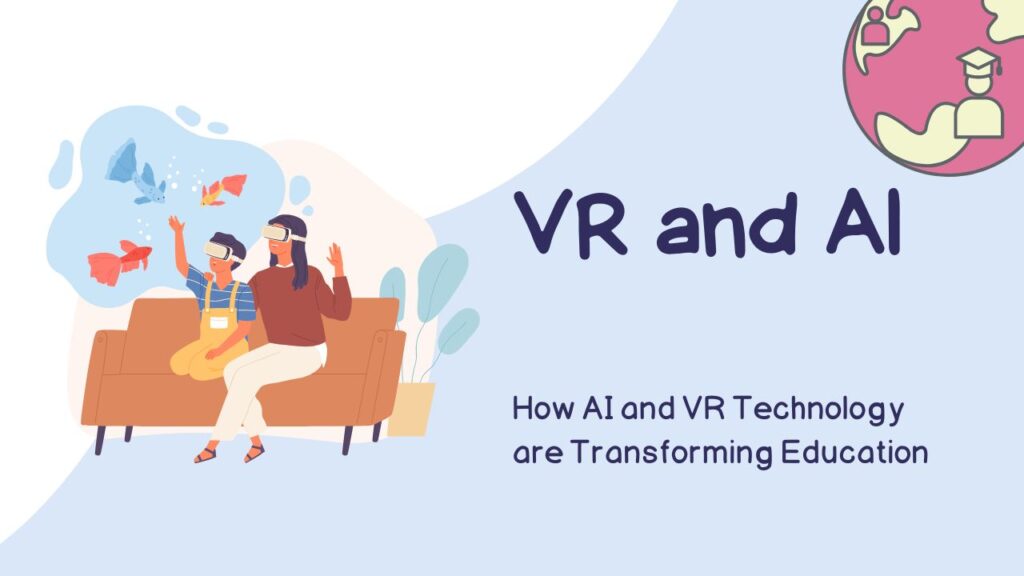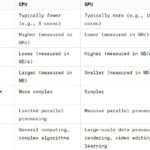Once upon a time, our idea of a classroom involved four walls, a chalkboard, and a barrage of textbooks. Fast-forward to now, where we stand on the precipice of a revolution in education, with the rise of Artificial Intelligence (AI) and Virtual Reality (VR).

A classroom now is not confined to four walls, rather it has been expanded to encompass the entire digital universe. It’s time to delve deeper into the impacts and potential these technologies hold for learning.
Table of Contents
The Future is Now: Education with AI and VR
AI: The Future of Personalized Learning
You might be thinking, “How does AI fit into the classroom?” Well, it’s all about personalization. We’re talking about a learning experience tailored to each student’s individual needs.
Imagine a teacher who knows every student’s strengths, weaknesses, and learning styles — and can adapt teaching methods on the fly. Sounds pretty futuristic, right? Well, this is where AI enters the scene.
AI-based learning platforms can analyze a student’s interaction with the material and adapt the content accordingly. It identifies areas where the student excels and where they might need some extra attention. What this means for students is a learning journey that’s uniquely theirs.
Moreover, AI can streamline administrative tasks, taking the load off teachers’ shoulders, and leaving them more time to focus on, well, teaching!
This results in an improved educational experience, benefiting both teachers and students. The tech-savvy approach not only makes education more effective but also engaging.
Immersive Learning with VR
VR is all about bringing learning to life. Remember the circulatory system dive we talked about earlier? Well, that’s the magic VR brings into the classroom.
VR has the power to turn abstract concepts into tangible experiences, enhancing comprehension and retention.
For instance, instead of reading about the Great Pyramids, students can virtually visit Egypt, explore the site, and see the Pyramids’ grandeur.
It’s like taking a field trip without leaving the classroom! This sort of immersive experience can provide a richer understanding of the subject matter that no textbook can deliver.
Besides, VR can also simulate situations for practical learning. Think about a chemistry lab or a surgical procedure; VR can create these scenarios risk-free.
Not only does this kind of learning instill confidence, but it also ensures students can apply their knowledge in real-world settings.
Experiencing is Believing
Interactive Education
In the olden days, students were mere recipients of information. Today, with AI and VR, the tables have turned.
These technologies have brought a paradigm shift in education, stimulating students to be active participants in their learning journey.
How do they do it? Here are a few examples:
Interactive Content
AI brings an entirely new dimension to education through its ability to create interactive content. Imagine, instead of merely reading about a scientific concept, you can engage with it via an AI-powered simulation.
This could range from gamified puzzles that make learning feel like play to multimedia presentations that captivate the senses.
The use of AI can also animate complex ideas in accessible ways, turning abstract theories into something concrete and understandable.
The result? A surge in curiosity and critical thinking makes learning not just an obligation but a fun and exciting exploration.
Virtual Field Trips
With VR, the idea of a field trip has been entirely redefined. Students can now embark on virtual journeys to anywhere in the world (or even outside it) without ever leaving their classrooms. Want to walk through the ancient pyramids of Egypt?
Or how about a stroll on the surface of Mars? VR makes it possible, offering immersive, 3D explorations of such environments.
These “trips” provide context, make abstract concepts tangible, and foster an appreciation for global and cosmic perspectives.
Role-Playing Scenarios
Another fascinating application of AI and VR in education is role-playing. These technologies can simulate real-world scenarios, allowing students to enact historical events, business environments, or medical emergencies.
Imagine a history class where students can “live” the French Revolution or a medical course where students can “experience” conducting a complicated surgical procedure.
By offering a first-person perspective, role-playing scenarios facilitate a deeper understanding of the subject matter and foster empathy and perspective-taking.
Collaborative Learning
One of the most transformative impacts of immersive learning experiences is the fostering of collaboration. The shared, multi-user environments created by VR not only make learning more engaging but also promote teamwork.
Students can work together on projects in virtual workspaces, communicating and interacting in real time. This collaboration hones essential skills such as communication, negotiation, and problem-solving. Plus, it mirrors the dynamics of real-world team projects, preparing students for their future workplaces.
Learning by Practicing
A wise man once said, “Tell me and I forget, teach me and I may remember, involve me and I learn.” This quote hits the nail on the head when it comes to VR’s contribution to education.
By fostering an environment where students can dive headfirst into practice, VR facilitates a deeper, more interactive understanding of the subject at hand.
STEM Advancements
Diving into the complexities of STEM subjects, VR simulations enable students to manipulate molecular structures, helping them understand complex shapes better. Traditional textbooks can only offer so much with 2D diagrams. But with VR, you’re not just looking at a model of DNA; you’re twisting it, turning it, and observing it from all angles.
The beauty of VR lies in its ability to provide a hands-on experience and generate curiosity among students. It allows them to visualize scientific phenomena that would otherwise remain abstract concepts. This immersive way of learning helps students comprehend intricate structures and mechanisms that are often too small or too complex to envision otherwise.
Overcoming Fear
Many students grapple with fears that can affect their academic performance, such as stage fright, which can inhibit public speaking skills. But here’s where VR can help.
VR-based exposure therapy can place students in a virtual auditorium, allowing them to practice and become comfortable with public speaking in a safe, controlled environment. Over time, students can gain the confidence to speak in public without the anxiety that often accompanies it.
This form of therapy can prove instrumental in shaping a student’s ability to communicate effectively, a skill that goes far beyond the classroom.
Empowering Creativity
Imagine a virtual canvas that’s not restricted by size, shape, or even gravity. Sounds like an artist’s paradise, right? VR opens the door to such possibilities, fostering artistic expression in unprecedented ways.
From sculpting in 3D to painting in virtual reality, students can explore and nurture their creativity beyond physical limitations.
This immersive technology provides a revolutionary platform for young artists to experiment, create, and learn. By transforming the way art is made and perceived, VR fosters a more inclusive and innovative environment for creative expression.
Wrapping Up: The Impact of AI and VR on Learning
To sum up, the impact of AI and VR on learning is profound. They provide personalized, immersive learning experiences, making education more engaging, efficient, and fun.
AI allows us to understand and cater to each student’s unique needs, turning the ‘one-size-fits-all’ model of education on its head. On the other hand, VR takes students beyond the confines of the classroom, enabling them to experience and explore concepts in ways they never thought possible.
Of course, these technologies also pose challenges, like access, cost, and the need for training. But as they continue to evolve and become more accessible, they could well reshape the future of education.
So, are you ready for the educational revolution? Let’s embrace the future of learning, where AI and VR are not just fancy buzzwords but integral parts of the learning process!




